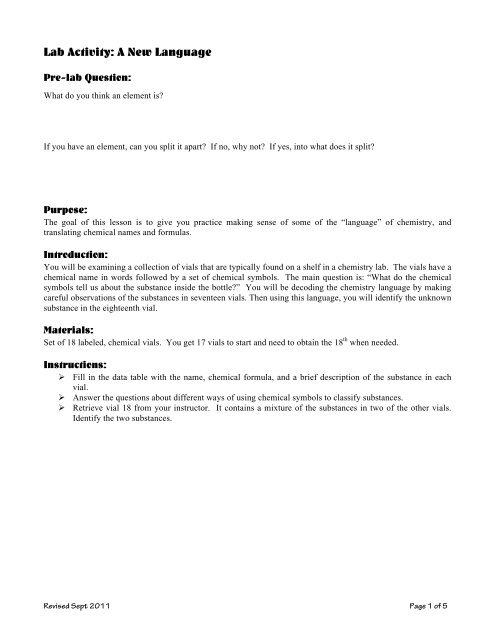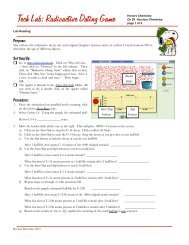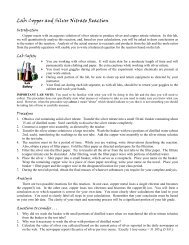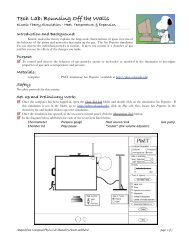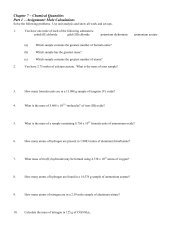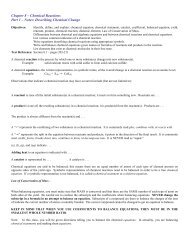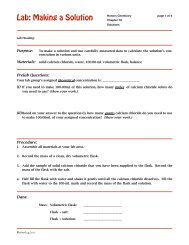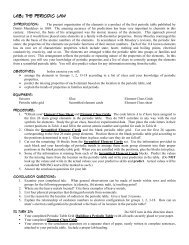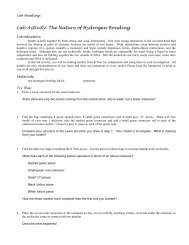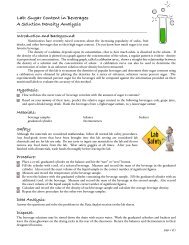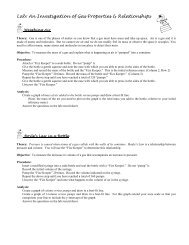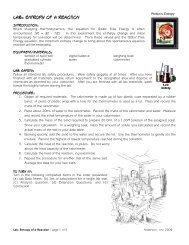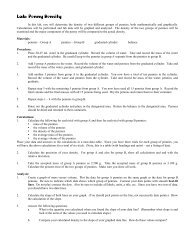Lab Activity: A New Language - Honors Chemistry Coursework
Lab Activity: A New Language - Honors Chemistry Coursework
Lab Activity: A New Language - Honors Chemistry Coursework
- No tags were found...
Create successful ePaper yourself
Turn your PDF publications into a flip-book with our unique Google optimized e-Paper software.
<strong>Lab</strong> <strong>Activity</strong>: A <strong>New</strong> <strong>Language</strong>Pre-lab Question:What do you think an element is?If you have an element, can you split it apart? If no, why not? If yes, into what does it split?Purpose:The goal of this lesson is to give you practice making sense of some of the “language” of chemistry, andtranslating chemical names and formulas.Introduction:You will be examining a collection of vials that are typically found on a shelf in a chemistry lab. The vials have achemical name in words followed by a set of chemical symbols. The main question is: “What do the chemicalsymbols tell us about the substance inside the bottle?” You will be decoding the chemistry language by makingcareful observations of the substances in seventeen vials. Then using this language, you will identify the unknownsubstance in the eighteenth vial.Materials:Set of 18 labeled, chemical vials. You get 17 vials to start and need to obtain the 18 th when needed.Instructions: Fill in the data table with the name, chemical formula, and a brief description of the substance in eachvial. Answer the questions about different ways of using chemical symbols to classify substances. Retrieve vial 18 from your instructor. It contains a mixture of the substances in two of the other vials.Identify the two substances.Revised Sept 2011 Page 1 of 5
<strong>Lab</strong> <strong>Activity</strong>: A <strong>New</strong> <strong>Language</strong><strong>Lab</strong> Heading:Data TableName Chemical Formula DescriptionVial 1Vial 2Vial 3Vial 4Vial 5Vial 6Vial 7Vial 8Vial 9Vial 10Vial 11Vial 12Vial 13Vial 14Vial 15Vial 16Vial 17Vial 18Revised Sept 2011 Page 2 of 5
Analysis Questions:1. Observe the contents of the vials and their labels. Create a numbered list of at least eight patterns you noticeabout the information on the vial label and/or the material in the vial.2. The following symbols represent elements in the substances in the vials. Identify each element.Na _________________________Zn _________________________S _________________________N _________________________3. How do you translate the following words into chemical symbols?sulfate _________________________hydroxide _________________________nitrate _________________________oxide _________________________4. Compounds are substances made of more than one element that are chemically combined. On your datatable, place a “C” next to the number of each vial that contains a compound.5. What do you think g, l, and s in parentheses represent?6. How would you write the chemical formula for ice? _________________________7. What do all the substances labeled (aq) have in common?8. What is the difference between l and aq?9. What is in your Vial 18? How did you arrive at this conclusion?10. Could the substance in vial 4 also be in vial 18? Must the substance in vial 4 be in vial 18? Can youdefinitively tell using observation only?Revised Sept 2011 Page 3 of 5
Extensions:Additional Information: An element is a unique form of matter that serves as a building material for more complex matter.Elements cannot be broken apart chemically into two different substances. Each element has a name and a chemical symbol. The symbols for elements consist of upper case lettersthat are sometimes followed by lower case letters. Each upper case letter, along with the lower caseletter, if there is one, is a symbol for a different element. These are all listed on the periodic table youwere supplied at the start of this course. Sometimes the symbol relates to the name of the element andsometimes the symbol comes from its language of origin or an ancient language, like Greek. Sometimes elements combine chemically (they react with one another) to create a new substance that ismade of a specific arrangement of multiple elements. These collections are called compounds. A compound is a substance that consists of two or more elements chemically combined together in a setratio, resulting in a neutral end product. A chemical formula is the set of symbols a scientist uses to represent a chemical compound. It is thecombination of the symbols of its constituent elements. Often, subscripts are part of a chemical formula;these represent the number of the element or ion directly preceding the subscript. For example, carbon dioxide is a chemical compound made of both carbon and oxygen. Its formula isCO 2 indicating carbon dioxide is made of 1 carbon atom and 2 oxygen atoms. Copper (II) sulfate is also a compound with a formula CuSO 4 ; this tells us that copper (II) sulfate is madeof 1 copper atom, 1 sulfur atom, and 4 oxygen atoms. A final example: the compound zinc (II) nitrate has a formula of Zn(NO 3 ) 2 . The subscript 2 outside theparentheses indicate that there are two nitrate ions in this compound. So all totaled, this compoundconsists of 1 zinc, 2 nitrogen, and 6 oxygen atoms.11. For each of the substances in the first seventeen vials, write the formula (include all symbols), list how manyatoms of each element exist in the substance, as well as the total number of atoms in the entire substance.Vial 1Vial 2Vial 3Vial 4Vial 5Vial 6Vial 7Vial 8Vial 9Vial 10Vial 11Vial 12Vial 13Vial 14Vial 15Vial 16Vial 17substance atoms of each element total # of atomsRevised Sept 2011 Page 4 of 5
The Next LevelThis set of questions extends the ideas from the main part of the lab to a new topic, writing chemical formulas. Ifyou do not know all your ions, you may need to refer to your ion list to complete this portion of the activity.12. Copper (II) sulfate is a neutral compound. It is made of two ions: copper (II) and sulfate.a. What is the charge on copper (II)? ____________________b. What is the charge on sulfate? ____________________c. In this compound, what is the ratio of copper ions to sulfate ions? ____________________d. Why do you think copper (II) and sulfate combine in a one-to-one ratio?13. Sodium nitrate is a neutral compound. It is made of two ions: sodium and nitrate.a. What is the charge on the sodium ion? ____________________b. What is the charge on the nitrate ion? ____________________c. In this compound, what is the ratio of sodium ions to nitrate ions? ____________________d. Why do you think sodium ions and nitrate combine in a one-to-one ratio?14. You want to write the chemical formula for the substance created by the combination of sodium ions andsulfate ions.a. What is the charge on the sodium ion? ____________________b. What is the charge on the sulfate ion? ____________________c. When they combine, what do you think is the ratio of sodium ions to sulfate ions? ___________________d. What is the chemical formula of the compound, called sodium sulfate? ____________________15. You want to write the chemical formula for the substance created by the combination of zinc and nitrate ions.a. What is the charge of the zinc ion? ____________________b. What is the charge of the nitrate ion? ____________________c. When they combine, what do you think is the ratio of zinc ions to nitrate ions? ___________________d. What is the chemical formula of the compound, called zinc nitrate? ____________________16. You want to write a chemical formula for the substance created by the combination of aluminum ions andoxide ions.a. What is the charge of the aluminum ion? ____________________b. What is the charge of the oxide ion? ____________________c. When they combine, what do you think is the ratio of aluminum to oxide ions? ___________________d. What is the chemical formula of the compound, called aluminum oxide? ____________________17. You want to write the chemical formula for the substance created by the combination of iron (III) ions andcarbonate ions.a. What is the charge of the iron (III) ion? ____________________b. What is the charge of the carbonate ion? ____________________c. When they combine, what do you think is the ratio of iron (III) to carbonate ions? ___________________d. What is the chemical formula of the compound, called iron (III) carbonate? ____________________Revised Sept 2011 Page 5 of 5


